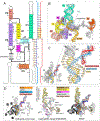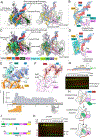Structural basis for RNA-guided DNA cleavage by IscB-ωRNA and mechanistic comparison with Cas9
- PMID: 35617371
- PMCID: PMC10041819
- DOI: 10.1126/science.abq7220
Structural basis for RNA-guided DNA cleavage by IscB-ωRNA and mechanistic comparison with Cas9
Abstract
Class 2 CRISPR effectors Cas9 and Cas12 may have evolved from nucleases in IS200/IS605 transposons. IscB is about two-fifths the size of Cas9 but shares a similar domain organization. The associated ωRNA plays the combined role of CRISPR RNA (crRNA) and trans-activating CRISPR RNA (tracrRNA) to guide double-stranded DNA (dsDNA) cleavage. Here we report a 2.78-angstrom cryo-electron microscopy structure of IscB-ωRNA bound to a dsDNA target, revealing the architectural and mechanistic similarities between IscB and Cas9 ribonucleoproteins. Target-adjacent motif recognition, R-loop formation, and DNA cleavage mechanisms are explained at high resolution. ωRNA plays the equivalent function of REC domains in Cas9 and contacts the RNA-DNA heteroduplex. The IscB-specific PLMP domain is dispensable for RNA-guided DNA cleavage. The transition from ancestral IscB to Cas9 involved dwarfing the ωRNA and introducing protein domain replacements.
Conflict of interest statement
Competing Interests
The authors declare competing financial interests on IscB-ωRNA structure-inspired genome editing applications.
Figures




Comment in
-
Structure-based evolutionary relationship between IscB and Cas9.Cell Res. 2022 Oct;32(10):875-877. doi: 10.1038/s41422-022-00709-8. Cell Res. 2022. PMID: 35931820 Free PMC article. No abstract available.
-
Snapshots of a tiny ancestral nuclease of Cas9.Trends Biochem Sci. 2023 Jan;48(1):9-10. doi: 10.1016/j.tibs.2022.08.008. Epub 2022 Sep 10. Trends Biochem Sci. 2023. PMID: 36100522
References
MeSH terms
Substances
Grants and funding
LinkOut - more resources
Full Text Sources
Other Literature Sources

